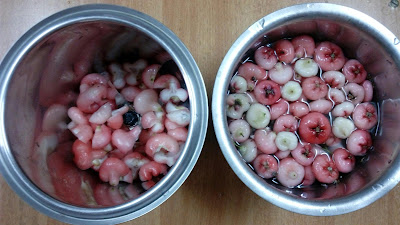Chambakka was introduced to me when I visited my friend's house in Mannarkkad a few years back. I was at first skeptical how it would taste but then liked to munch on it whenever I caught hold of it. It is grown almost in many backyards of Kerala's houses. It is citrusy and good to just have them as such or with chilli powder-salt mix (as we have the raw mangoes).
My daughter (GK) helped her friend with her accountancy subject preps for her semesters and in return got a whole lot of chambakka (and some yummy mangoes too). Munching and munching on, we finished almost half of them but had lots more.
The other options of using chambakka were to make wine, jam, pickle etc. I had the grape wine and amla wine in stock and wanted no more wine. I felt it would be apt to make a cool, refreshing juice with the chambakka to beat this hot and scorching summer's heat and I wasn't wrong on thinking so. Yes, it turned out to be a really good coolant when had it chilled and tasted so good that we couldn't stop with 1 glass of it.
Chambakka is also called the rose apple, wax apple, water fruit, bell fruit, java apple etc. It is rich in vitamin C and blossoms only in summers.
Now, let's try this simple recipe.
Ingredients:
Chambakka - 1 kg
Sugar - 1/2 cup
Lemon Juice - 1 to 2 tbsp
Water - 5 to 6 cups
Salt - 1/4 tsp
Method:
Wash and clean chambakka of any seeds.
Chop them into pieces.
In a mixer jar, add chopped chambakka and about 2 to 3 glasses of water and grind well.
Notes:
My daughter (GK) helped her friend with her accountancy subject preps for her semesters and in return got a whole lot of chambakka (and some yummy mangoes too). Munching and munching on, we finished almost half of them but had lots more.
The other options of using chambakka were to make wine, jam, pickle etc. I had the grape wine and amla wine in stock and wanted no more wine. I felt it would be apt to make a cool, refreshing juice with the chambakka to beat this hot and scorching summer's heat and I wasn't wrong on thinking so. Yes, it turned out to be a really good coolant when had it chilled and tasted so good that we couldn't stop with 1 glass of it.
Chambakka is also called the rose apple, wax apple, water fruit, bell fruit, java apple etc. It is rich in vitamin C and blossoms only in summers.
Now, let's try this simple recipe.
Ingredients:
Chambakka - 1 kg
Sugar - 1/2 cup
Lemon Juice - 1 to 2 tbsp
Water - 5 to 6 cups
Salt - 1/4 tsp
Method:
Wash and clean chambakka of any seeds.
Chop them into pieces.
In a mixer jar, add chopped chambakka and about 2 to 3 glasses of water and grind well.
Strain the chambakka puree through a strainer to get clear juice underneath.
To the clear chambakka juice, add sugar, salt, lime juice, and water as needed and run again in the mixie so that everything blends well. Adjust sugar, water, and salt and also lime juice as per personal taste.
Store in refrigerator until use and serve chilled. Yummy and cool chambakka juice is ready.
It is really a great refresher and a super cooler. Don't miss to experience it. Ah!! It is not be missed!!
Thanks to GK's friend. If she had not generously given so much of the chambakka, I wouldn't have tried this at all and would have missed this juicy pleasure.
Save and dry the residue (obtained while straining the puree) which can be used as a supplementary addition while making rotis, dosas, etc.
Soak sabja seeds in water and add to the chambakka juice and serve chilled. An additional coolant it is. This is optional.












